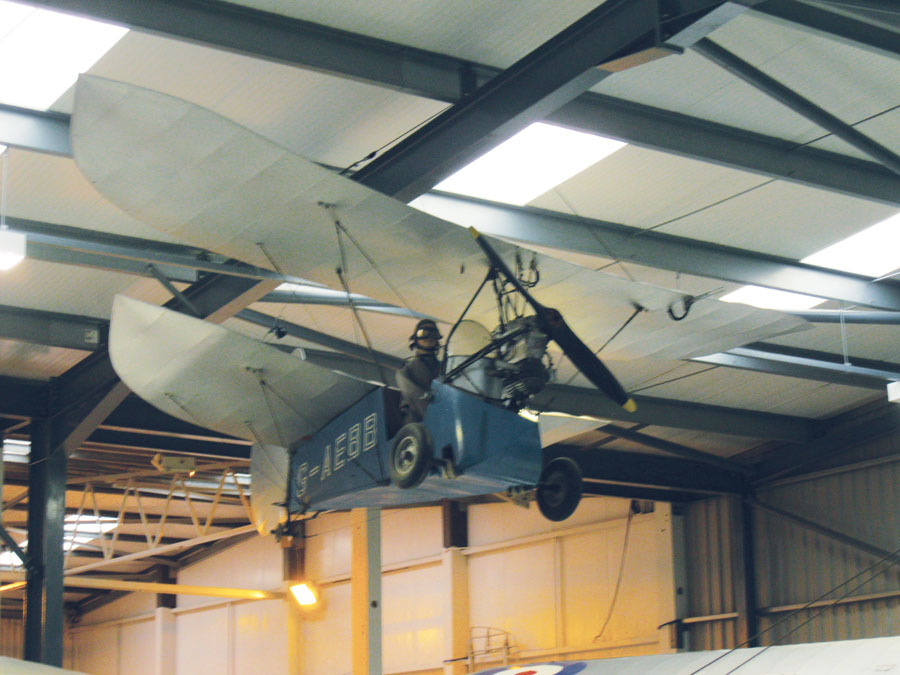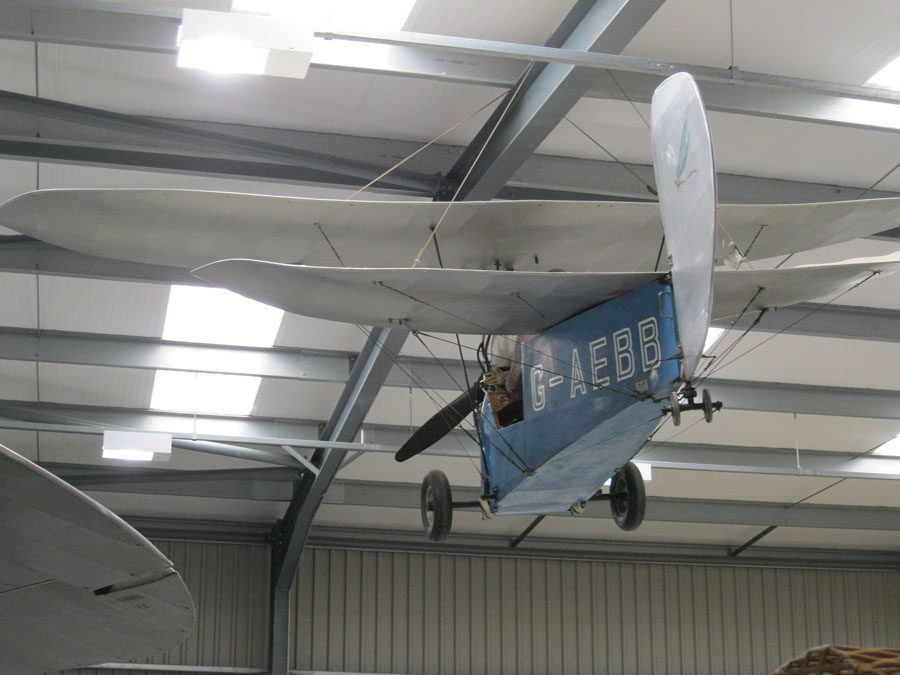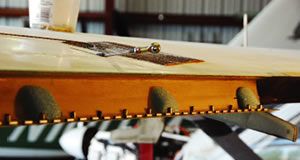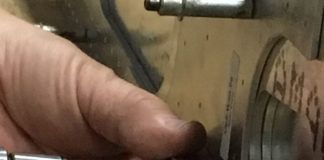
An original HM.14 Pou du Ciel, also known as a “Flying Flea,” on display at the Shuttleworth Collection Museum in Old Warden, Bedfordshire, England.
For the past few months we have been examining the stability and control characteristics of trikes. As we saw, a large vertical distance between the wing and the CG produces significant nonlinearity in the variation of pitching moment with angle of attack.
Another configuration that has a large vertical offset of the CG is the Pou du Ciel, or “Flying Flea.” The Pou was in many ways the first homebuilt in the modern sense, in that it was intentionally designed to be built by amateurs and flown just for the joy of flying.
The Pou was designed by Frenchman Henri Mignet. Mignet loved flying but was, by his own account, a poor pilot who had great difficulty coordinating turns and avoiding stalling the airplane. He set out to create a stall-resistant airplane that an amateur could build easily and fly safely with minimal pilot skill. The Pou was the result.
The Pou was a close-coupled tandem-wing airplane with the front wing mounted high on cabane struts and the rear wing mounted on top of the fuselage. It had no ailerons. Lateral/directional control was provided by a large all-moving rudder combined with wing dihedral, making the Pou a two-control airplane.
It was controlled in pitch by varying the incidence of the front wing. In this, the Pou had two features of a modern trike: low CG and control by varying the angle between the wing and the mast connecting the wing to the body. In some respects, rather than a tandem wing, the Pou is a trike with a tail. The original Pou (The HM.14) first flew in 1933. Mignet published an account of his work, as well as plans and instructions for building the HM.14 in a book, Le Sport de L’air, published in 1934. It was soon translated into English. The book set off a movement, and many HM.14s were built in Europe and England, as well as other places. It’s worth reading even today if for no other reason than Mignet’s exuberant descriptions of the joy of flying.
The initial enthusiasm for the Pou was dashed when there were a series of fatal Pou accidents. These accidents were unlike any seen with conventional airplanes. They occurred when pilots approaching to land put the nose down to descend toward the field. The airplane did not settle onto a steady glide path. Instead the dive angle steepened progressively, and the Pou dove into the ground. It appeared that this steepening dive was unrecoverable, and the pilot was not able to pull out of it. After seven such fatal accidents, great concern about the inherent safety of the HM.14 led to government intervention.

The Pou was in many ways the first homebuilt in the modern sense, in that it was intentionally designed to be built by amateurs and flown just for the joy of flying.
Wind Tunnel Tests
The Pou was grounded, and wind tunnel tests were performed in both England and France. The HM.14 was a relatively small airplane, and it was therefore possible to test full-size airplanes both in the French wind tunnel at Chalais-Meudon and the British RAE 24-foot wind tunnel at Farnborough.
The British test at Farnborough was relatively limited in scope and was primarily concerned with the behavior of the airplane at low angles of attack. The French test was more extensive. A copy of the complete RAE report, as well as images of a French-language magazine article describing the French tests can be found online.
Unsurprisingly, there are some detail differences between the quantitative results of the two full-scale tests. The two tests used two different homebuilt airplanes, so it’s not surprising to any modern homebuilder that there were detailed differences between the two ships. The British experimenters measured their test article (G-AEFV) very carefully and found, among other things, that both wings had wash-in, and there was as much as 1.5 degrees of difference in the tip incidence of the left and right tips of the wings.
Despite the differences between the tunnels and test airplanes, the results from the two tests were essentially the same.
1. The airplane was stable at high angles of attack and unstable at low angles of attack. It became progressively more unstable as angle of attack decreased. (Note that this change in stability with angle of attack is the same as we saw in our analysis of trikes in the past few months.)
Quoting the British report conclusions: “in the dive the instability becomes more marked.”
2. The problem worsened as the CG was moved aft, and many Poux were flying with the CG as far aft as 50% of the front wing chord.
Quoting the British report conclusions: “The airplane is unstable in normal flight with the CG further back than 40% chord.”
(Author’s [B.W.] comment: This was of particular concern since the pilot sat aft of the CG, making the balance of the airplane sensitive to the weight of the pilot. A light pilot might be flying with the CG far enough forward to be safe, while a heavier pilot would encounter dangerous instability.)
3. At some negative angle of attack (-15 degrees in the British test and -9 degrees in the French test), even full-back stick could not command a positive nose-up pitching moment.
This last finding is widely misinterpreted in modern writings about the Pou. I have seen many statements that the airplane would become unrecoverable at glide angles of -9 to -15 degrees. This is not true. The critical angle is the angle of attack of the airplane relative to the airstream, not the flight-path angle relative to the ground.
Looking at these results, we can see how builders of the original Pou got in trouble.
The prototype HM.14 had only 17 hp. It was not able to fly very fast, and therefore in level flight, it flew only in the angle of attack range where it was reasonably stable and controllable. By his own account Mignet was a relatively timid pilot, so it seems unlikely that he would have intentionally dived the airplane.
Later builders used more powerful engines. They also varied in weight and piloting style. It seems natural that a heavier pilot would use a more powerful engine in order to have an acceptable rate of climb. In this case, we would have a more powerful airplane flying faster than Mignet, with the CG farther aft because of the pilot seat position. This made the airplane less stable and also more likely to fly at lower angles of attack where the instability set in.
Conclusions
Here are some notes from the British wind-tunnel report conclusions and their implications:
“When the airplane is trimmed in a dive it is in unstable equilibrium; i.e., if for some reason the airplane departed from its steady glide, the divergence would increase unless corrected by the pilot.”
A gust can provide the initial disturbance, even if the pilot has initially captured the desired airspeed at zero pitch rate. Also, the airplane, if disturbed nose down, will continue to pitch nose-down at an ever-increasing rate if the pilot holds constant pressure on the stick.
“With unstable equilibrium, the stick must be pushed forward to initiate the preliminary motion of a dive and then immediately pulled back beyond its initial position.”
This is a very unnatural thing for a pilot to do. Pilots expect a constant stick position to command a constant airspeed. It’s easy to see how a pilot would move the stick forward to start a descent and then be caught by surprise when the nose continued to drop at an increasing rate.
“The airplane cannot be flown “hands-off” since it needs constant correction. It is obvious that a dive must be approached carefully so the desired attitude is not overshot. Overshooting may be dangerous since the airplane may reach the ground before it can be righted….”
The Pou was intended to be flown by amateur, probably self-taught, pilots. Mignet’s goal in evolving the Pou configuration was to eliminate the stall/spin and the need to coordinate turns to make flying easier and safer. Unfortunately, while he largely succeeded in making the Pou spin resistant and flyable with two controls, he inadvertently introduced another, even more dangerous, flying qualities problem.
The instability and pitch-control nonlinearity of the original HM.14 at lower angles of attack would make it difficult or impossible for even an extremely skilled pilot to fly safely. It’s not surprising that a significant number of low-time amateur pilots were fatally caught out by it.
The problem was particularly insidious because it did not appear over the whole flight envelope. A pilot who had flown his Pou repeatedly in the low-speed flight regime and found it to be docile and easily controllable could decide to fly a bit faster, or try a slightly steeper descent than he had before and suddenly find himself dealing with a machine that was dangerously unstable and running away with him. The odds that he could figure it out in time to prevent an accident were tragically low.
Eventually, Mignet and others found ways to fix the problems of the original HM.14, and many Pou-style airplanes have been built and flown successfully and safely. The Pou formula still has its devotees, particularly in Europe.
Much has been written (a lot of it wrong) about the sources of the HM.14 instability and how to fix it. Next month we will take a more detailed look at the sources of the problem and fixes to the configuration to make it safe to fly.

![]()
Barnaby Wainfan is a principal aerodynamics engineer for Northrop Grumman’s Advanced Design organization. A private pilot with single engine and glider ratings, Barnaby has been involved in the design of unconventional airplanes including canards, joined wings, flying wings and some too strange to fall into any known category.













